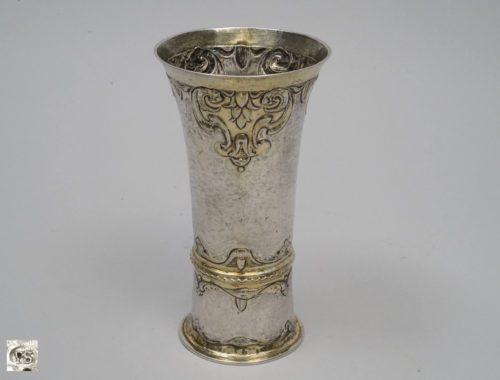Detailed Description
Detailed information
Hermannstadt beaker, partially gilt
Silver, partially gilt, chased, engraved, hallmarked
According to István Heller, silver cups from Transylvania are characterized by their coming two-part, particularly elegant and slim shape, the cylindrical, hollow base and a conically curved wall with a broad lip rim. This is decorated by elaborately fine engraving which is partially gilt. In addition to the typical features of a Kluftbecher, many of the silver cups have a circumferential, grooved wavy band, which is surrounded by two reinforcing rings, as a connection between the high foot standing on a smooth, narrow base ring and the slender cup.
A Hermannstadt Beaker
The present partially gilt silver beaker from the goldsmith’s center in Hermannstadt, a city in Romania that originally belonged to the Austro-Hungarian Empire, is an excellent example of this special form of the Transylvanian goblet. Elaborately chased, engraved and gilded friezes on the base of the cup, above and below the characteristic wavy band and below the lip rim, create a skilful contrast to the smooth, silver intermediate surfaces of the cup wall. The polished, gilded lip edge is bordered by an engraved, horizontal line that is deliberately overlapped by the embossed, all-round frieze. This consists of chased and engraved scrollwork, stylized hanging hop umbels and foliage. The wavy band and the standing ring are also surrounded by a narrow frieze made of curls, stylized acorns and leaves, which stand out effectively against the punched background. The original gilding of the cup underlines its clear horizontal structure as well as the finely crafted driving and engraving of the decoration. A combination of these decorative elements can often be found on cleft beakers from Transylvania.
Goldsmith’s art from Transylvania
The elegant Kluftbecher fits seamlessly into a larger group of silver beakers from Hermannstadt and Kronstadt, which were made around the middle of the 17th century. They come from the important goldsmith’s center in Transylvania, a Hungarian province that mined a third of European silver and gold before the early 16th century and later also supplied large quantities of precious metals. In contrast to numerous European goldsmiths centers, this region was not dependent on the import of gold, silver and copper, but had these raw materials in large quantities, so that it was not necessary to melt down older silver objects. Instead, the goldsmiths obtained their precious materials from local mines. Wolfram Koeppe reported on the Hungarian goldsmith’s art in 2015 on the website of the Metropolitan Museum of Art, New York.
Comparative examples:
A similar cleft beaker, dated 1639 by Georgius Renner, with three friezes made of flattened curving, stylized fruits, palmettes and leaves, as well as a comparable chalice-shaped beaker in the Germanisches Nationalmuseum Nürnberg, Inv. No. KG1226 by Michael Gundert around 1640 from Hermannstadt / Sibiu, Romania are shown in István Heller, p. 213 and p. 215.
Master
Petrus Schnell II was a member of a family of goldsmiths that worked in Sibiu for several generations. Three goldsmiths in the family used a similar maker’s mark with the initials PS. Petrus II Schnell became a master craftsman in 1637 and is recorded in Sibiu until 1657.
Literature
Heller, István: Hungarian and Transylvanian goldsmiths from the end of the 16th century to the end of the 19th century, Munich 2000.
Klusch, Horst, Siebenbürgische Goldschmiedekunst, Bucharest 1988, No. 322 (on the maker’s mark)
Koeppe, Wolfram, “Hungarian Silver.” In: Heilbrunn Timeline of Art History. New York: The Metropolitan Museum of Art, 2000–. (http://www.metmuseum.org/toah/hd/hung/hd_hung.htm (February 2016), last accessed on December 14, 2021)
Köszeghy, Elemér: Marks of the goldsmiths of Hungary. From the Middle Ages to 1867, Budapest 1936, No. 1402 (to the maker’s mark)
Roth, Victor: Art monuments from the Saxon churches of Transylvania I, goldsmithing, Hermannstadt 1922, No. 447, Fig. 95
Rosenberg Marc: Der Goldschmiede Merkzeichen, Volume 4, Abroad and Byzantium, Frankfurt / Main 1928, pp. 459-461 (for Hermannstadt see: https // digi.ub.uni-heidelberg.de/diglit/rosenberg1928bd4/0491?nixda= 1 & ft / last accessed on December 23, 2021)



